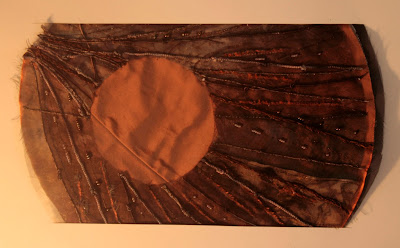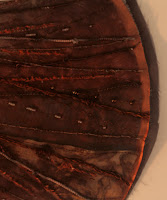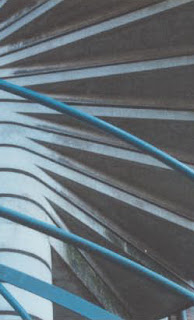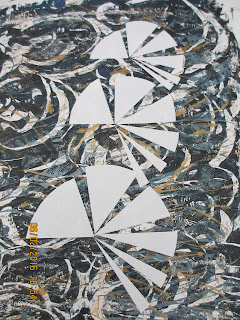This collection of buttons has been waiting on my desk ready to photograph and write about. During that time I've continued collecting threads and beads excited by their colour, texture and potential. Worse than that the books on my self are full of post-it notes, to say nothing about the browsing and borrowing of library books. What did Victoria Wood sing, "Just do it!"
So here then is my button collection using fabric, threads and beads in my ice-blue, rich brown and greys colour scheme.
Wrapped Cores, starting from twelve o'clock:
1. Round core covered with self-dyed cotton,with gold rub on spiral enhanced with beading.
2. Round core covered on matte silk gathered in several small spirals topped with small gold sequins.
3. Rectangular core covered with silk and enhanced with threads and bits, then wrapped with beaded threads.
4. Padded wrapped rectangular core wrapped in chiffon and beaded threads.
5. More obviously wrapped rectangular core (parcel-like), using bought patterned hand-dyed fabric and wrapped with beads and small sequins.
6. Round core covered in chiffon and decorated on the top with a hand-dyed chiffon strip gathered to create a flower the centre studded with tiny springs, beads and sequins
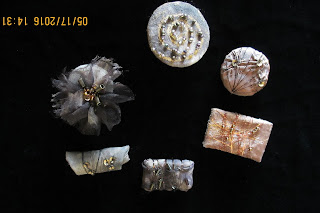 |
| Buttons using wrapped cores |
Toggle Buttons, from left to right:
7. Layered and different width fabric (cotton and silk) rolled round cylindrical core and tied with faux leather strip.
8. Another cylindrical core wrapped in cotton enhanced with threads and bits, then decorated with band of velvet which has been beaded.
9. Layers of corrugated card covered with cut thread stretching beyond the core. This was then wrapped with a gathered and beaded strip of chiffon -- utterly impractical as a button, as many of these ideas are.
 |
| More buttons using wrapped cores |
Dorset Buttons, starting from nine o'clock
10. Metal ring wrapped in soft silk floss.
11.Double card ring wrapped randomly with soft silk floss and strips of blue nylon knotted at intervals.
12.Metal ring wrapped in multi thread cords, leaving the centre free.
13.Metal ring wrapped in multi thread cord filling the centre.
14.Medium size ring wrapped in hand dyed sari silk the ring then parcelled round in fine irridescent thread.
15.Double card ring solidly wrapped in a silk strip and enhanced with beaded thread.
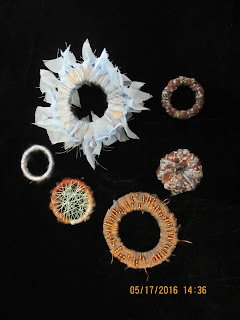 |
| Dorset buttons |
Domed Buttons:
 |
| Domed buttons |
Four samples showing a combination of felt and thin copper sheet then machine using spirals or zigzag to distort the shape. Further distortion created by applying pressure in a circular motion to the copper.
Tyvek Toggle Buttons:
I haven't used Tyvek before so I carried out a little bit of research including watching Carolyn Saxby's blog which was very helpful.
I had a Gwen Hedley pack languishing in my cupboard already cut into A4 pieces. I painted both weights of the Tyvek on each side using acrylic paint in my colour scheme. I also sent for some Lumiere light body metallic acrylic in old brass, metallic rust and pewter which I'm hoping to use at some stage. The instructions about using Tyvek given by Carolyn Saxby on her blog were very helpful.
 |
| Painted Tyvek sample colours |
 |
| Sample 1 |
Above are four samples of Tyvek layers molded by playing the heat gun over them creating interesting surface textures and profiles. Tempting though it is to try and speed up the process it's not a good idea to hold the heat gun too close as the Tyvek can become molded on to the kebab stick and become impossible to remove. Slower is also good for another reason: it's important to consider the effects made by the heat gun: is it time to stop or push distortion even further. Ensure that the ends are treated.
 |
| Sample 2 |
The above four samples show the addition of threads and beads. The colour combinations are more subtle and therefore more pleasing.
 |
| Sample 3 |
These three samples show an experimental sequence in the use of adding text.
From the left the first sample uses a strip of an art flyer (advertising the Giacometti exhibition at Sainsbury Centre in Norwich which is now on). Although I thought the strip was fairly narrow it was too long and the paper too thick for the heat to mold the Tyvek and in so doing change the shape of the paper.
The middle sample uses a small piece of newsprint and here I was concerned about setting fire to it. This did not happen and the hot Tyvek and the newsprint together with the threads are melded into one, though maybe the proportion of newsprint to coloured Tyvek leaves the newsprint too dominant.
The third sample shows better proportions of newsprint to Tyvek. I also included some metallic fabric in copper and this has also partially melted. The threads too -- silk slub and a polyester rainbow thread works well.
I do like the idea behind these samples. There is something of John Dee, the Elizabethan spymaster, about them, as if some secret code or instructions are wrapped inside and only half revealed. I could also imagine using pieces of map, a postcode . . .
Incised Toggle Buttons:
 |
Toggle buttons incised with a Soldering Iron
|
 |
| Flat buttons incised with a Soldering Iron |
Like some new skills I found using a soldering iron quite tricky. The design needs careful forethought as the soldering iron affects the materials instantly. Some of the buttons I layered with a number of fabrics both man-made and natural, but unlike my heat gun samples I don't feel the effect shows this. Maybe a soldering iron is a tool for very specific work, though much more practice would be needed to answer that question.


